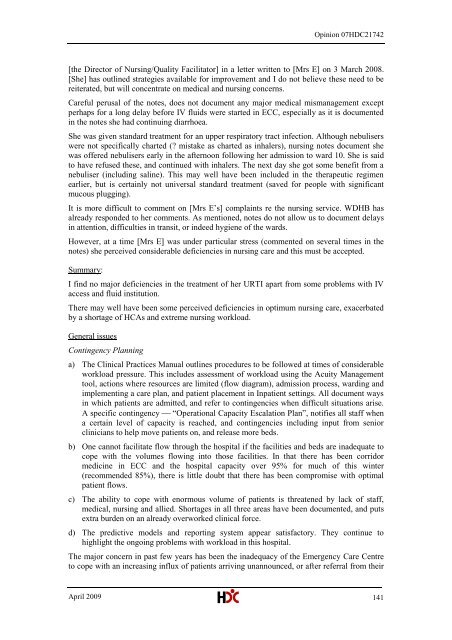North Shore Hospital report - New Zealand Doctor
North Shore Hospital report - New Zealand Doctor
North Shore Hospital report - New Zealand Doctor
Create successful ePaper yourself
Turn your PDF publications into a flip-book with our unique Google optimized e-Paper software.
Opinion 07HDC21742[the Director of Nursing/Quality Facilitator] in a letter written to [Mrs E] on 3 March 2008.[She] has outlined strategies available for improvement and I do not believe these need to bereiterated, but will concentrate on medical and nursing concerns.Careful perusal of the notes, does not document any major medical mismanagement exceptperhaps for a long delay before IV fluids were started in ECC, especially as it is documentedin the notes she had continuing diarrhoea.She was given standard treatment for an upper respiratory tract infection. Although nebuliserswere not specifically charted (? mistake as charted as inhalers), nursing notes document shewas offered nebulisers early in the afternoon following her admission to ward 10. She is saidto have refused these, and continued with inhalers. The next day she got some benefit from anebuliser (including saline). This may well have been included in the therapeutic regimenearlier, but is certainly not universal standard treatment (saved for people with significantmucous plugging).It is more difficult to comment on [Mrs E‘s] complaints re the nursing service. WDHB hasalready responded to her comments. As mentioned, notes do not allow us to document delaysin attention, difficulties in transit, or indeed hygiene of the wards.However, at a time [Mrs E] was under particular stress (commented on several times in thenotes) she perceived considerable deficiencies in nursing care and this must be accepted.Summary:I find no major deficiencies in the treatment of her URTI apart from some problems with IVaccess and fluid institution.There may well have been some perceived deficiencies in optimum nursing care, exacerbatedby a shortage of HCAs and extreme nursing workload.General issuesContingency Planninga) The Clinical Practices Manual outlines procedures to be followed at times of considerableworkload pressure. This includes assessment of workload using the Acuity Managementtool, actions where resources are limited (flow diagram), admission process, warding andimplementing a care plan, and patient placement in Inpatient settings. All document waysin which patients are admitted, and refer to contingencies when difficult situations arise.A specific contingency ―Operational Capacity Escalation Plan‖, notifies all staff whena certain level of capacity is reached, and contingencies including input from seniorclinicians to help move patients on, and release more beds.b) One cannot facilitate flow through the hospital if the facilities and beds are inadequate tocope with the volumes flowing into those facilities. In that there has been corridormedicine in ECC and the hospital capacity over 95% for much of this winter(recommended 85%), there is little doubt that there has been compromise with optimalpatient flows.c) The ability to cope with enormous volume of patients is threatened by lack of staff,medical, nursing and allied. Shortages in all three areas have been documented, and putsextra burden on an already overworked clinical force.d) The predictive models and <strong>report</strong>ing system appear satisfactory. They continue tohighlight the ongoing problems with workload in this hospital.The major concern in past few years has been the inadequacy of the Emergency Care Centreto cope with an increasing influx of patients arriving unannounced, or after referral from theirApril 2009 141
















